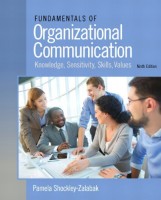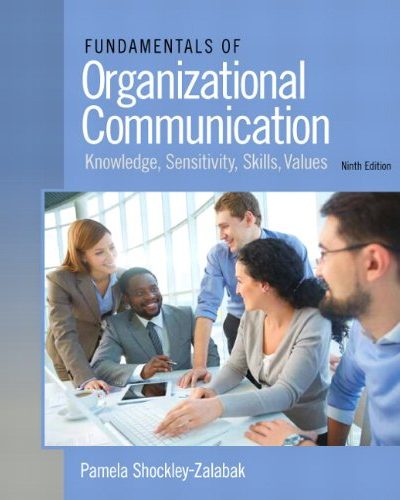 Author: Pamela S. Shockley-Zalabak
Author: Pamela S. Shockley-Zalabak
Publisher: Pearson – 474 pages
Book Review by: Sonu Chandiram
Effective communication within organizations – academia, businesses, government agencies, hospitals, non-profits, and other entities, to give you some examples – is essential to our very existence in the twenty-first century.
Imagine the fear that could spread and the chaos that would ensure if some dangerous and life-threatening misinformation – intentional or not – is spread “like wildfire” in our highly interconnected society with the Internet, newspapers, radio, television, and social media, that influences our behavior, and endangers us, and others ?
In a recent related events, two nurses, 26-year-old Nina Pham and 29-year-old Amber Vinson, contracted the Ebola virus after treating Thomas Eric Duncan of Liberia at Texas Health Presbyterian Hospital in Dallas.
How did they contract the Ebola virus from Duncan? The investigation is going on now
While it was widely believed (and broadcast by government health authorities) that this virus can only be contracted when people come into contact with the body fluids of an Ebola virus victim, recent research has shown that the virus can also be contracted through the air, or breathing in the same environment shared with an Ebola victim.
But the previous information of virus contraction only through contact with body fluids has already been spread widely through various media of mass communication. Although this was essentially unintended misinformation because not enough was or is known, the new information of spread through the air has a lot of people in fear and panic, especially the people working at that Dallas hospital. What is going to happen now? We shall have to wait and see.
The above example demonstrates how important it is for the members of an organization to communicate safely and effectively so that no one gets affected adversely. Besides this imperative, the book covers other fundamentals of organizational communication, which are discussed in the book’s chapters and appendix we name below:
- Organizational Communication: A Competency-Based Approach
- Perspectives for Organizational Communication
- Communication Implications of Major Organizational Theories
- Organizational Communication: Values and Ethical Communication Behaviors
- Individuals in Organizations
- Groups in Organizations
- Leadership and Management Communication
- Participating in Organizations: Developing Critical Organizational Communication Competencies
- Organizational Conflict: Communicating for Effectiveness
- Organizational Innovation, Change, and Communication
- Strategic Organizational Communication: Professional Applications of Organizational Communication
- Career Options for Organizational Communication
Appendix: Putting It All Together
- Hockaday Responders: Teams Across Time and Space
- Your Personal Development Workbook
- Cases and Essays
The author uses a unique competency-based approach in this book. Why this approach? She writes that the answer is simple: “organizing material by competency components is academically relevant, individually practical, and important to organizations.” This makes perfect sense.
Four competencies are developed by the students and readers who use this book: knowledge, sensitivity, skills, and values. Each chapter outlines on the first page, the topics discussed in it in terms of these four competencies.
This is followed by discussions of each topic. Towards the end of each chapter, a review of the material is aided with these features:
- Chapter Highlights
- Workshop
- Tips for Effective Communication
- References and Suggested Readings
Besides using the competency-based approach which makes the book more effective in teaching important concepts to students, Shockley-Zalabak points out that her work is designed to train individuals in organizations “who take personal responsibility for building relationships that contribute to trust, quality communication, innovation, and change.” A great book on organizational communication.
Author:
Pamela S. Shockley-Zalabak is affiliated with the University of Colorado.







